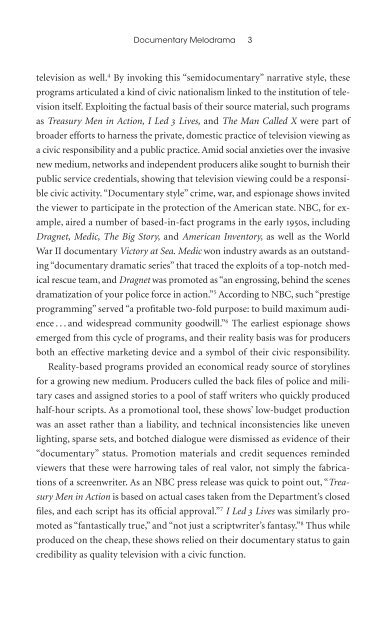Citizen-Spy
Citizen-Spy
Citizen-Spy
Create successful ePaper yourself
Turn your PDF publications into a flip-book with our unique Google optimized e-Paper software.
xxii Introduction<br />
Wild Wild West (CBS, 1965–70). Also on the air were several British imports,<br />
which were both popular and very economical purchases for the U.S. networks.<br />
6 These included The Avengers (ABC, 1966–69), Secret Agent (CBS, 1965–<br />
66), The Saint (ABC, 1967–69), and The Prisoner (NBC, 1968). Throughout the<br />
mid-1960s, espionage emerged not so much as a genre unto itself, but rather as<br />
an inversion of other, more established generic narrative forms. Whether explicitly<br />
comic or linked to action and crime dramas, by the mid-1960s the spy was<br />
often a mechanism for disrupting and sometimes reconfiguring assumptions<br />
about televisual narrative, the coherence and stability of heroic protagonists,<br />
and the relationship between individuals and institutions.<br />
This is not to say that the figure of the spy was stripped of its ideological<br />
pull as an ideal national citizen. In I <strong>Spy</strong> (NBC, 1965–68), this ideal is reinvigorated<br />
by a turn toward cultural relevance, diffracting spy programs’ interrogation<br />
of agency onto ongoing cultural debates over African American citizenship<br />
and civic responsibility. In the program, the first dramatic series to star<br />
an African American actor, the civil rights movement and pan-Africanism collide;<br />
I <strong>Spy</strong> tests the geopolitical implications of black American travel and social<br />
mobility. In Mission: Impossible (CBS, 1966–73), longest running and last of the<br />
period’s spy dramas, the notion of individual agency is nearly completely evacuated;<br />
its agents are anonymous mercenaries in service to the bureaucratic<br />
state. Mission: Impossible was also one of the first American television programs<br />
crafted specifically so as to ensure success on the international syndication<br />
market. The result is a contradictory text that is both intensely nationalistic<br />
and carefully circumspect about how its racial and cultural representations<br />
might interfere with its commercial viability. Spiraling outward from domestic<br />
postwar containment through the international “development decade,” by the<br />
end of the 1960s these programs offered a model of American national identity<br />
that increasingly diverged from official state institutions, and instead was articulated<br />
alongside consumption, class privilege, and global mobility.<br />
The shifts in these shows’ representations of American national identity<br />
were closely tied to the changing political, cultural, and ideological landscape<br />
of the Cold War. Popularized by journalist Walter Lippman’s 1947 book of the<br />
same title, the term “Cold War” has since become a kind of structuring shorthand,<br />
an endlessly expansive phrase that has come to encapsulate the zeitgeist<br />
of an era. The term’s origins, though, lay in the postwar geographic and politi



